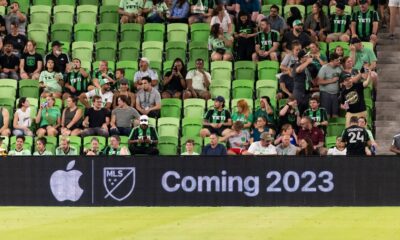On Saturday, largely ignored by the national media, another new American soccer club will be born. And once again, it looks like being another success story. Jacksonville Armada will open their NASL campaign and they hope to beat the league’s regular season attendance record of 14,593.
It is another sign that North American club soccer is booming – and it’s not all about Major League Soccer. While MLS continues to break towards the American sporting mainstream in communities across the United States, lower division clubs are putting down roots in a way that has never been seen before.
Jacksonville hasn’t featured on the frequent lists of cities likely to be included in the next round of MLS expansion talks. But if attendance and interest is as high as the Armada expect in their debut season, you can be sure that there will be some wondering if Jacksonville aren’t going to be the next Orlando or Minnesota. Then again, the same could be said of Sacramento Republic in the third tier USL, or the NASL’s San Antonio Scorpions.
It is hard, at the moment, to think of a city in the U.S. that wouldn’t embrace a new soccer club – if that club does all the necessary marketing and community work to establish their presence and credibility. With a soccer specific stadium built in the right part of town, MLS could set-up shop in almost any city in the nation and find a population ready to embrace it.
But there are only so many cities MLS can accept. The league may well expand past 24 clubs, to 28 or even 32, but that would still leave significant, large cities in North America without a top flight professional soccer club. That’s why MLS can never be the be-all and end-all of American club soccer.
Think about this list of non-MLS cities: Phoenix, Austin, Detroit, Cleveland, San Diego, Pittsburgh, Baltimore, Birmingham, Nashville, Charlotte, St.Louis, Las Vegas, New Orleans, Tampa, Cincinnati. You could add others of course and there is no reason why smaller communities across the country couldn’t embrace a team.
The same can be said for all of North America’s major leagues of course but there is a crucial difference – when it comes to American football and basketball, those large cities without an NFL or NBA team will have a college team to satisfy the demand for big-time local games in the sport. College soccer, though, is never going to fill the gap.
In the rest of the world, it is completely normal, of course, for towns and cities of all sizes to have professional soccer teams playing at varying levels in their country’s pyramid. Most have long histories and deep roots that took hold when the game was establishing itself. North America is finally undergoing that process, a century later than Europe but it faces some key decisions in the coming years.
Because MLS is a closed league, open only to clubs who can pay the large entrance fee and win the backing of the league office and the owners of the existing MLS clubs, the dream of rising through the divisions isn’t open to the smaller communities in the United States. That is a pity but a reality nonetheless.
That doesn’t mean that those clubs can’t survive or even prosper – English football has scores of professional clubs who are vibrant presences within their community despite never having a realistic shot at reaching the Premier League – but it does mean that U.S. Soccer, if it wants to help the game spread at all levels, needs to think hard about how to harness the enthusiasm that is seeing clubs being set up at all levels.
The U.S. Open Cup is the perfect way to channel the energy of lower level soccer into a competition that gives them the chance to face the likes of L.A. Galaxy and New York City FC. How can it not be good for the game to give fans in Jacksonville or Louisville a chance to see their local team up against the likes of Steven Gerrard and Robbie Keane or Frank Lampard and David Villa?
Yet the tournament is treated like the unwanted stepchild of American soccer. Despite offering its own rich history, which touches upon every era in the ups and downs of the game in this country, the competition is barely televised, hardly marketed and not taken seriously by MLS clubs. This is an area where U.S Soccer could take the lead and really energize the competition. With promotion and relegation unlikely to be on the agenda for many years (if ever), the Cup offers the chance to open the game up – to allow the small clubs to dream of their day of glory.
The Cup is a huge missed opportunity but U.S. Soccer also needs to wary of the dangers inherent in the ad-hoc layers of leagues that it has allowed to develop. There is a risk of ‘turf wars’ between USL and NASL that will only harm the game. It is one thing for the two leagues to compete for potential investors looking to set up clubs – another thing altogether if the leagues place new clubs in existing markets and risk destroying whatever has been built. So far there have only been skirmishes but it is a danger that US Soccer needs to be alert to.
SEE ALSO: Watch or listen to the interview with NASL Commissioner Bill Peterson on Soccer Morning.
USL’s bid to be designated a ‘Division Two’ league would, if successful, create the ludicrous situation of American soccer having two competing second divisions, neither of which would offer promotion to the first division or relegation to a (non-existent) third division. It is hardly likely to discourage the potential turf wars.
US Soccer needs to have a serious think about how it wants to see professional club soccer structured. The games has moved to a level where a laissez faire attitude of simply being glad that leagues exist is no longer adequate. MLS, NASL and USL are all going to follow their own interests but there is no guarantee that those interests are always going to coincide with what makes the most sense for a growing sport. The history of American soccer offers plenty of examples where selfish feuds have undone years of progress.
SEE ALSO: Watch or listen to an interview with USL Commissioner Jake Edwards on Soccer Morning.
There is so much talk about ‘player development’ in American soccer but the lower divisions offer one of the best ways for players to emerge and grow as professionals. If America truly is becoming, as Don Garber has suggested, a ‘Soccer Nation’ then it needs to make sure it has a national structure that can capitalize on growth and not fall apart under the strain of it.
Editor’s note: Every Thursday, World Soccer Talk featured columnist Simon Evans shares his thoughts and opinions on world soccer topics. You can follow Simon on Twitter at @sgevans. Plus, read Simon’s other columns for World Soccer Talk.
200+ Channels With Sports & News
- Starting price: $33/mo. for fubo Latino Package
- Watch Premier League, World Cup, Euro 2024 & more
Live & On Demand TV Streaming
- Price: $35/mo. for Sling Blue
- Watch Premier League, World Cup & MLS
Many Sports & ESPN Originals
- Price: $9.99/mo. (or get ESPN+, Hulu & Disney+ for $13.99/mo.)
- Features Bundesliga, LaLiga, Championship, & more
2,000+ soccer games per year
- Price: $4.99/mo
- Features Champions League, Serie A, Europa League & NWSL
175 Premier League Games & PL TV
- Starting price: $4.99/mo. for Peacock Premium
- Watch 175 exclusive EPL games per season
110+ channels, live & on-demand
- Price: $59.95/mo. for Plus Package
- Includes FOX, FS1, ESPN, TUDN & more























btk99
April 3, 2015 at 2:05 pm
Detroit City FC of the NPSL sells out every home match at 3,200 people and is moving into a larger stadium. It has a supporters group of several hundred strong (Northern Guard) and in 3 years already has established chants, songs, and rivalries. And this is in the 4th division UN-paid league. Certainly it also deserves a mention, but more so it just adds to the author’s point. There is more, much more, to American soccer than the MLS.
El Conductor
April 2, 2015 at 8:32 pm
Chattanooga FC of the NPSL drew nearly 9,000 for their league semifinal game in July of last year. That deserves a mention among the non-MLS cities.
CTBlues
April 2, 2015 at 11:06 pm
Saw them play in the NPSL final at RedBull Arean last year vs the RedBull youth team. Sat in the RedBull supporters section for the MLS game and then moved to the Chattanooga travelers section for their game and was rooting for them.
Dean Stell
April 2, 2015 at 5:28 pm
Well….I think part of the issue is that MLS wants people in non-MLS markets to watch MLS on TV. And I’ve always had a problem with that because MLS isn’t an elite TV product. The soccer is fine and improving, but its national ratings will always be tied to the quality of the play and the star quality on the field……just like in any other sport.
That’s no an “MLS sux” argument. In fact, MLS probably does better with ratings that it should. I mean, the quality of soccer is similar to the English championship and I bet it gets way better ratings than the Championship.
But….MLS does need to come up with some way to work with the rising tide of American soccer. They have a unique problem among all American sports. It’s the only American major league that isn’t the undisputed BEST in the world. And it’s also the only sport with growing/thriving professional leagues outside of its purview.
I’m not sure what the right answer is. It’s easy to just yell “pro/rel”, but I’m sure the answer is more sophisticated than that. It’s why Don Garber makes more money than me.
CTBlues
April 2, 2015 at 8:03 pm
You should look at how many pro American football leagues there were in this country between the 1920’s and 1950’s.
jtm371
April 2, 2015 at 10:43 pm
Would disagree about mls on same level of Championship. No mls side would win promotion to EPL. IMO closer to League 1.
Total Relegation @totalrelegation
April 2, 2015 at 3:03 pm
The problem in the U.S. is not soccer but MLS. MLS has had 20 years to try their single-entity experiment and we are still seeing empty stadiums on National TV like we did in Chicago this past weekend. That is unacceptable and to even attempt to blame this outcome on weather is utterly disappointing.
On the other hand, NASL has adopted an open system with independent clubs and in its short time it has produced clubs that made the jump to MLS and the opposite can’t be said for MLS. In fact, MLS failed attempts have just vanished (ChivasUSA).
Jim
April 2, 2015 at 6:20 pm
The Puerto Rico Islanders, Virginia Cavalry, and Oklahoma City FC all say hello.
WSW
April 2, 2015 at 9:34 pm
PR Islanders was gov’t funded team, Virginia Cavalry/Oklahoma never played a game…Chivas did and folded. BTW those last 2 aren’t dead yet.
StrikersFan
April 2, 2015 at 2:46 pm
Well, an article written my Mr. Evans that I can agree with him on about 90% of. What a wonder! Excellent points about the US Open Cup and the lack of management of the overall structure of the game in the US by the USSF. These are questions that have been around for awhile now that no one at US Soccer seems in an hurry at all to answer. US Soccer really seems to care very little about what happens in the game in the US outside of MLS and the national team. Quite a shame, but what is the catalyst for change? Who kicks Gulati in the ass and tells him to get on it?
Of course there is something else to add regarding this piece of your article as well:
“It is hard, at the moment, to think of a city in the U.S. that wouldn’t embrace a new soccer club – if that club does all the necessary marketing and community work to establish their presence and credibility. With a soccer specific stadium built in the right part of town, MLS could set-up shop in almost any city in the nation and find a population ready to embrace it.”
The answer of course is Miami. Cheerio mate!
CTBlues
April 2, 2015 at 1:08 pm
The reason US Soccer doesn’t do anything with the US Open Cup and ignores the lower divisions is because it is in MLS’ pocket. USL saw this and made a deal with MLS to ensure it’s future in the soccer landscape. US Soccer will continue to allow Oklahoma City situations to happen as long as it hinders NASL and helps MLS/USL.
Dan
April 2, 2015 at 12:19 pm
I think people should start wondering if MLS is actually killing off the lower divisions by taking their best supported teams to MLS. Imagine if we could have a solid/strong lower division base in US soccer. That alone is a terrific funnel for players to develop to make it to MLS as well as possibly one day having pro/rel at least in only the non-MLS leagues.
Kevin
April 2, 2015 at 12:16 pm
Interesting article but you begin with what appears to me to be an unrealistic complaint that the establishment of the Jacksonville Armada was “largely ignored by the national media.”
And why should the national media care about what is, in the American vernacular, a minor league team in a sport that, while growing, is still far from being a national passion?
Sometimes those of us who love the game (and I have for 30+ years) forget that people (and the media) mostly don’t care. It’s better than it was but there’s still a lot of room for growth.
Paul Scanling
April 2, 2015 at 11:52 am
Excellent points, Simon. I think US Soccer is so fixated on developing MLS that they aren’t paying enough attention to the other leagues. Guidance from that organization is necessary to allow the sport to develop properly. Of course, they would then have to admit that MLS isn’t the ‘end-all, be-all’ of the sport. I’m not sure they are willing to do that yet, and it could potentially hurt the lower divisions.
The US Open Cup should be marketed front and center by US Soccer. It’s a shame that it isn’t.
max
April 2, 2015 at 12:53 pm
Yes I don’t know why US Open Cup isn’t pushed more, especially considering the History.
I wonder if a NCAA ‘March Madness’ or WC tournament style consecutive double-header games format would work better?
Perhaps they could play it in Feb pre-MLS season in places like California, Florida, Hawaii and a few indoor stadiums elsewhere.
At least in Feb it would be center of attention instead of being played through MLS season, Int friendly tournaments like Guiness cup and World Cup.